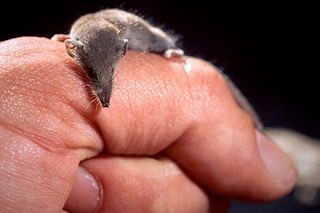
The Etruscan shrew, also known as the Etruscan pygmy shrew, white-toothed pygmy shrew and Savi’s pygmy shrew, is the smallest known extant mammal by mass, weighing only about 1.8 g (0.063 oz) on average.

The red-toothed shrews of the subfamily Soricinae are one of three living subfamilies of shrews, along with Crocidurinae and Myosoricinae. In addition, the family contains the extinct subfamilies Limnoecinae, Crocidosoricinae, Allosoricinae and Heterosoricinae. These species are typically found in North America, northern South America, Europe and northern Asia. The enamel of the tips of their teeth is reddish due to iron pigment. The iron deposits serve to harden the enamel and are concentrated in those parts of the teeth most subject to wear. Members of the genera Chimarrogale, Nectogale, Neomys (Nectogalini) and some members of Sorex (Soricini) are known as water shrews, due to having a semi-aquatic lifestyle.

The white-toothed shrews or Crocidurinae are one of three subfamilies of the shrew family Soricidae.

The American pygmy shrew, also called the eastern pygmy shrew, is a small shrew found throughout much of Alaska, Canada, and the northern contiguous United States, as well as south along the Appalachian Mountains and in a small region in the Colorado and Wyoming Rockies. The species was first discovered in 1831 by naturalist William Cane in Georgian Bay, Parry Sound.
Betaretrovirus is a genus of the Retroviridae family. It has type B or type D morphology. The type B is common for a few exogenous, vertically transmitted and endogenous viruses of mice; some primate and sheep viruses are the type D.

The International Committee on Taxonomy of Viruses (ICTV) authorizes and organizes the taxonomic classification of and the nomenclature for viruses. The ICTV develops a universal taxonomic scheme for viruses, and thus has the means to appropriately describe, name, and classify every virus taxon. The members of the International Committee on Taxonomy of Viruses are considered expert virologists. The ICTV was formed from and is governed by the Virology Division of the International Union of Microbiological Societies. Detailed work, such as identifying new taxa and delimiting the boundaries of species, genera, families, etc. typically is performed by study groups of experts in the families.

The West African pygmy shrew or obscure white-toothed shrew is a species of mammal in the family Soricidae. It is found in Ivory Coast, Ghana, Guinea, Liberia, and Sierra Leone. Its natural habitat is subtropical or tropical moist lowland forests.
In 2008, by pyrosequencing of cDNA from the brains of several parrots suffering from proventricular dilatation disease (PDD), Honkavuori et al. identified the presence of a novel bornavirus.

Virology Journal is an open-access peer-reviewed medical journal published by BioMed Central. It publishes research related to viruses and the prevention of viral infection. The journal was established in 2004 with Robert Garry as founding editor-in-chief and has been edited by Linfa Wang since 2012. It aims to cover rapid communications amongst virologists.
Malacoherpesviridae is a family of DNA viruses in the order Herpesvirales. Molluscs serve as natural hosts, making members of this family the only known herpesviruses to infect invertebrates. There are currently only two species recognised in this family, both classified into separate genera. Disease associated with this family includes sporadic episodes of high mortality among larvae and juveniles. The family name Malacoherpesviridae is derived from Greek word 'μαλακός (malacos) meaning 'soft' and from Greek word 'μαλάκιον (malakion) meaning 'mollusc'.
A giant virus, sometimes referred to as a girus, is a very large virus, some of which are larger than typical bacteria. All known giant viruses belong to the phylum Nucleocytoviricota.
A transpoviron is a plasmid-like genetic element found in the genomes of giant DNA viruses.
Imjin thottimvirus(MJNV) is a single-stranded, enveloped, negative-sense RNA virus of the orthohantavirus genus in the Bunyavirales order. It is a newly identified hantavirus isolated from the lung tissues of Ussuri white-toothed shrews of the species Crocidura lasiura (order Soricomorpha, family Soricidae, subfamily Crocidurinae) captured near the demilitarized zone in the Republic of Korea during 2004 and 2005.
Nova virus is a single-stranded, negative-sense, enveloped RNA virus with a trisegmented genome. It belongs to one of the most divergent lineages of the hantavirus group, which consists of zoonotic viruses belonging to the family Bunyaviridae. As of now, no human cases of infection have been reported.

Sedoreovirinae was a subfamily of the Reoviridae family of viruses. Viruses in this subfamily are distinguished by the absence of a turreted protein on the inner capsid to produce a smooth surface.
Tahyna orthobunyavirus ("TAHV") is a viral pathogen of humans classified in the California encephalitis virus (CEV) serogroup of the Orthobunyavirus family in the order Bunyavirales, which is endemic to Europe, Asia, Africa and possibly China.
Aurivirus is a genus of viruses in the order Herpesvirales, and one of only two genera the family Malacoherpesviridae. Haliotid molluscs serve as natural hosts. There is only one species described in this genus, Haliotid herpesvirus 1 (AbHV-1), commonly known as abalone herpesvirus. A disease associated with this virus is acute ganglioneuritis.

Bamfordvirae is a kingdom of viruses. This kingdom is recognized for its use of double jelly roll major capsid proteins. It was formerly known as the PRD1-adenovirus lineage. The kingdom is named after Dennis H. Bamford who first promoted the evolutionary unity of all viruses encoding double jelly-roll major capsid proteins.
Asikkala virus (ASIV) is an Old World hantavirus isolated from Sorex araneus in Germany and the Czech Republic. It is suspected to have a geographical distribution mapping with Seewis virus.








